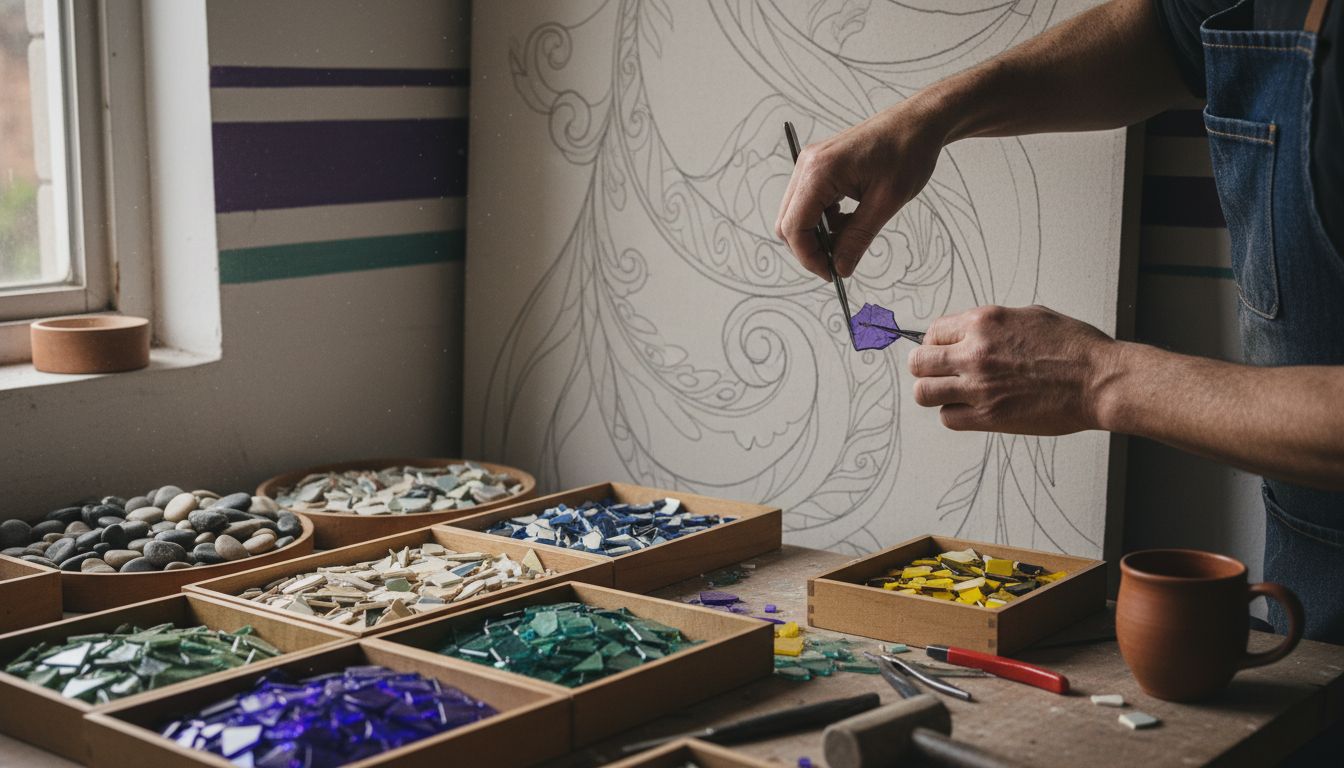Complete Guide to Why Select Mosaic Tiles
Posted by Mike Belk on Oct 27, 2025

More than 4,000 years ago, artisans began shaping tiny pieces of stone and glass into intricate masterpieces that still capture our imagination today. Early mosaic tiles, first developed in Mesopotamia, evolved into elaborate floor and wall art under Greek and Roman hands. Their timeless appeal endures, blending ancient artistry with modern versatility. Discover how these small but powerful tiles continue to inspire designers and homeowners with endless creative possibilities.
Table of Contents
- What Are Mosaic Tiles and Their Origins
- Major Types of Mosaic Tiles Available Today
- Aesthetic Versatility and Design Possibilities
- Durability, Maintenance, and Longevity Benefits
- Cost Considerations and Installation Factors
- Comparing Mosaic Tiles to Other Tile Options
Key Takeaways
| Point | Details |
|---|---|
| Mosaic Origin | Mosaic tiles originated in Mesopotamia in the 3rd millennium BC and were advanced by Greek and Roman civilizations. |
| Types of Mosaic Tiles | Modern mosaics come in various materials: glass, stone, ceramic, and smalti, each offering unique aesthetic and functional benefits. |
| Design Versatility | Mosaic tiles allow for remarkable artistic expression through diverse patterns and can enhance various residential and commercial spaces. |
| Durability & Maintenance | Mosaic tiles are notably durable and require minimal maintenance, making them a valuable long-term investment for any design project. |
What Are Mosaic Tiles and Their Origins
Mosaic tiles represent an ancient artistic technique of creating intricate designs by assembling small, carefully selected pieces of colored materials. According to the Smithsonian Institution, this remarkable art form originated in Mesopotamia during the 3rd millennium BC, with sophisticated developments by Greek and Roman civilizations who transformed these decorative elements into stunning visual narratives.
The core of mosaic art involves tesserae—small, precisely cut pieces of stone, glass, or ceramic—meticulously arranged to form complex patterns, images, and scenes. Historically, these tiny fragments were painstakingly positioned to create everything from elaborate floor decorations to breathtaking wall murals that told stories of mythology, daily life, and cultural significance. Learn more about mosaic tile history in our comprehensive guide on www.belktile.com/blog/what-is-mosaic-tile.
Unlike simple tiling techniques, mosaic art requires extraordinary skill and patience. Artists would select materials with specific colors and textures, cutting and positioning each tessera to create depth, perspective, and visual intrigue. The Romans, in particular, elevated mosaic craftsmanship to an extraordinary art form, using these techniques to decorate palaces, public spaces, and religious buildings with incredibly detailed and expressive designs.
Key characteristics of traditional mosaic tiles include:
- Precise, small-scale pieces (tesserae)
- Diverse material composition (stone, glass, ceramic)
- Intricate pattern and image creation
- Rich historical and cultural significance
- Remarkable artistic complexity

Major Types of Mosaic Tiles Available Today
Modern mosaic tiles showcase an impressive array of materials, each offering unique aesthetic and functional characteristics. According to research from Appropedia, contemporary mosaic tiles primarily encompass four main categories: glass, stone, ceramic, and smalti tiles, each bringing distinctive qualities to design and architectural applications.
Glass tiles, particularly Venetian glass mosaics, represent a pinnacle of artistic expression. These tiles are renowned for their vibrant colors and exceptional light-reflecting properties, creating dynamic visual landscapes in both interior and exterior spaces. Explore inspiring mosaic designs using different tile materials in our comprehensive guide on www.belktile.com/blog/the-art-of-mosaic-inspiring-designs-using-glass-ceramic-and-stone-tiles.
Stone and ceramic tiles offer more traditional and resilient mosaic options. Stone tiles provide natural textures and impressive durability, making them ideal for areas requiring robust surface treatments. Ceramic tiles, conversely, stand out for their remarkable versatility and weather resistance, suitable for diverse design contexts from kitchen backsplashes to outdoor patios.
Key characteristics of modern mosaic tile types include:
Here’s a comparison of the major types of modern mosaic tiles:
| Tile Type | Key Features | Typical Applications |
|---|---|---|
| Glass | Vibrant colors Reflective surfaces |
Bathrooms Kitchens Accents |
| Stone | Natural texture High durability |
Floors Outdoor spaces Walls |
| Ceramic | Versatile Weather-resistant |
Backsplashes Patios Fireplaces |
| Smalti | Opaque colors Historic appeal |
Murals Fine art installations |
- Glass tiles: Vibrant colors, reflective surfaces
- Stone tiles: Natural textures, high durability
- Ceramic tiles: Weather-resistant, versatile applications
- Smalti tiles: Rich historical significance, unique opaque colors
- Multiple material options for diverse design needs
Aesthetic Versatility and Design Possibilities
Mosaic tiles represent an extraordinary medium of artistic expression, offering unprecedented design flexibility across various spaces and styles. According to research from the Art & Nature Center, these intricate tile arrangements provide artists and designers with endless possibilities for creating personalized and visually stunning environments.
Color and pattern manipulation stands at the heart of mosaic tile design versatility. Designers can seamlessly blend different tile types, sizes, and materials to craft unique visual narratives that transform ordinary surfaces into extraordinary artistic statements. Discover innovative mosaic design techniques in our detailed guide on www.belktile.com/blog/types-of-mosaic-tiles-7-essential-types.
The adaptability of mosaic tiles extends far beyond traditional decorative applications. From intimate residential spaces to expansive public installations, these tiles can create intricate images, abstract patterns, or subtle textural landscapes. Modern design approaches leverage mosaic tiles’ ability to communicate mood, tell stories, and interact dynamically with surrounding architectural elements.
Key design possibilities with mosaic tiles include:
- Complex geometric patterns
- Realistic image representations
- Abstract artistic compositions
- Textural surface transformations
- Seamless color gradient effects
- Custom artistic installations
- Functional artistic statements in both indoor and outdoor environments
Durability, Maintenance, and Longevity Benefits
Mosaic tiles stand out as an exceptional flooring and design solution, offering remarkable durability that transcends typical surface treatments. According to the Smithsonian Institution, these intricate tile compositions have demonstrated extraordinary resilience, with historical examples surviving for centuries under diverse environmental conditions.
Material composition plays a critical role in mosaic tiles’ longevity. Glass and stone-based mosaics particularly excel in resistance to wear, moisture, and temperature fluctuations. Learn more about maintaining the pristine condition of your mosaic tiles in our comprehensive maintenance guide on www.belktile.com/blog/what-the-incrowd-wont-tell-you-about-mosaic-tile.
Proper installation and minimal maintenance are key to preserving mosaic tiles’ aesthetic and structural integrity. Unlike other decorative surfaces, these tiles require simple cleaning routines—typically involving mild detergents and soft cloths—to maintain their original brilliance. Their inherent resistance to staining, cracking, and fading makes them an intelligent long-term investment for both residential and commercial spaces.
Key durability advantages of mosaic tiles include:
- Exceptional environmental resistance
- Minimal maintenance requirements
- Resistance to staining and moisture
- Long-lasting aesthetic appeal
- Ability to withstand high-traffic areas
- Structural integrity over extended periods
- Adaptability to various temperature conditions
Cost Considerations and Installation Factors
Mosaic tile installation involves a complex interplay of material selection, design complexity, and professional expertise. According to research from the Museum of Fine Arts, the cost of mosaic tiles can vary significantly based on the materials chosen, with glass and smalti tiles typically commanding higher prices compared to ceramic or stone alternatives.
Installation complexity emerges as a critical factor in overall project expenses. Professional installation requires specialized skills, precise surface preparation, and meticulous tile placement. Explore our comprehensive guide to mosaic tile installation strategies on www.belktile.com/blog/types-of-mosaic-tiles-7-essential-types.
Budget-conscious homeowners and designers can optimize costs by carefully selecting materials and considering the scope of their project. Some strategies include choosing more affordable tile materials, limiting the total area of mosaic coverage, and potentially undertaking simpler installations as a do-it-yourself project. The long-term value of mosaic tiles often outweighs initial installation expenses, given their durability and aesthetic appeal.
Key cost and installation considerations include:
- Material price variations
- Professional vs. DIY installation
- Surface preparation requirements
- Design complexity impact on costs
- Long-term value and durability
- Potential for phased installation
- Maintenance and longevity factors
Comparing Mosaic Tiles to Other Tile Options
Mosaic tiles distinguish themselves from traditional tiling options through their unparalleled artistic flexibility and design potential. According to research from Appropedia, these unique tiles offer a level of customization and visual complexity that standard tiles simply cannot match, transforming surfaces from mundane to extraordinary.
Design versatility represents the most significant differentiator between mosaic and conventional tiles. While standard ceramic or porcelain tiles provide uniform coverage, mosaic tiles enable intricate patterns, complex imagery, and personalized artistic expressions. Discover more about selecting the perfect tile for your space in our comprehensive guide on www.belktile.com/blog/how-to-choose-the-backsplash-and-tile-that-are-right-for-your-home.
The installation process further separates mosaic tiles from traditional options. More labor-intensive and requiring specialized skills, mosaic tiling demands precision and artistic vision. However, this complexity translates into a unique aesthetic payoff—each installation becomes a custom piece of functional art, unlike the repetitive patterns of standard tile applications.
Key comparative advantages of mosaic tiles include:
- Unprecedented design customization
- Ability to create complex visual narratives
- Higher artistic expression potential
- More intricate texture and depth
- Greater visual complexity
- Unique personalization options
- Transformative design capabilities
Discover Your Perfect Mosaic Tile Solution with BELK Tile
Choosing mosaic tiles involves balancing artistic vision with durability and installation challenges. The article highlights key concerns such as selecting the ideal material—whether glass, stone, ceramic, or smalti—managing maintenance, and ensuring lasting beauty for your space. If you want to express your unique style with intricate patterns and vivid colors without compromising on quality or budget, BELK Tile offers a broad selection that meets these goals.
Explore our extensive range of mosaic tile options to find the perfect fit for your project. From vibrant glass mosaics to weather-resistant ceramic designs, BELK Tile provides detailed specifications and stunning visuals to guide your choice. Take advantage of our user-friendly platform where you can easily compare, shortlist, and purchase tiles online. Ready to elevate your space with timeless mosaic artistry? Visit BELK Tile to browse collections, get inspired by our detailed guides, and start transforming your vision into reality today.
Explore more on how to select the right mosaic tiles in our insightful Types of Mosaic Tiles Guide and discover practical tips from What the Incrowd Won’t Tell You About Mosaic Tile to maintain your investment’s lasting beauty.
Frequently Asked Questions
What are the key features of mosaic tiles?
Mosaic tiles are characterized by precise, small-scale pieces (tesserae), diverse materials such as stone, glass, or ceramic, and their ability to create intricate patterns and images that reflect rich historical and cultural significance.
How do mosaic tiles compare to traditional tiles?
Mosaic tiles offer unparalleled design flexibility and customization, enabling the creation of complex visual narratives and textures, in contrast to standard tiles which provide uniform coverage. This artistic expressiveness makes mosaics a more intricate and visually engaging option.
What types of mosaic tiles are available today?
Modern mosaic tiles are primarily classified into four main categories: glass, stone, ceramic, and smalti tiles. Each type has unique features, with glass offering vibrant colors, stone providing natural textures, ceramic being versatile and weather-resistant, and smalti offering rich historical appeal.
How do I maintain mosaic tiles to ensure their longevity?
Mosaic tiles are low maintenance. Regular cleaning with mild detergents and soft cloths is sufficient to keep them looking pristine. Their inherent resistance to staining, cracking, and fading contributes to their long-lasting aesthetic and structural integrity.



